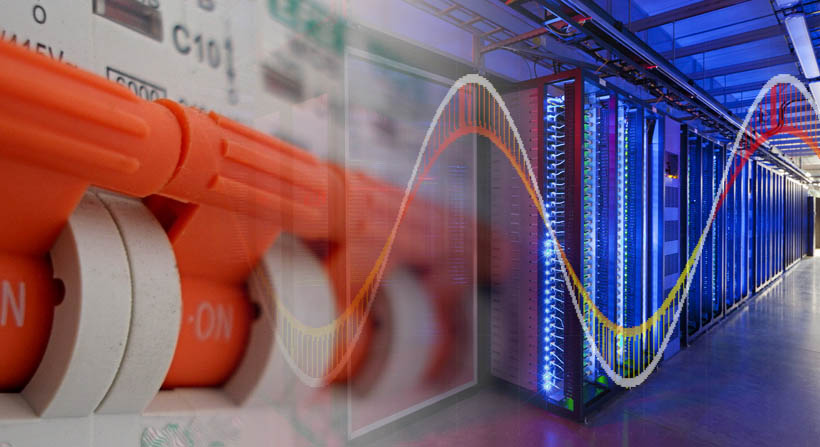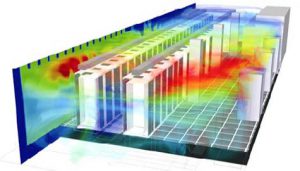
Data Center Instability Needs a Reliably Trackable Metric
It is understood that uptime is mission critical for a data center. We design our data centers with multiple redundancies, secondary and tertiary backup power, high quality components and infrastructure, distributed UPS and PDUs, and the list goes on. A lot of thought is put into the building of the infrastructure, layout and load profile for data centers to ensure stability of the electrical networks.
With all of this time, thought and effort put in, why are we nagged by the anxiety of a sudden power disrupting event? Why are we insecure about data center electrical network stability?
You may be surprised to learn that even with all of the sophisticated sensors and technologies that shroud data centers, the electricity is not controlled with precision. Electricity powers every single device operating in the data center, but operators do not clean and balance it in real time and much of the electrical energy is lost as heat.

Image Source: Red Current Ltd
In Tier 4 data centers, a significant component of management is spent evacuating the heat emitted by servers, power supplies, UPS, PDU, wires, etc. This heat is energy waste, but also a precursor to instability so is very important to monitor and prevent where possible.
Unfortunately, the market is headed in the direction of newer, better heat evacuation systems which is not very reassuring.
Heat in electrical networks is a clear sign that the electrical energy is being poorly transferred. Heat evacuation is essentially admitting defeat; it is technology to bail out a ship that has too many holes to float anyway. The logical solution is to prevent the heat from forming which requires a technology that focuses on the root cause of the heat, electricity.
 Today’s data center electrical network designs are pushing the thresholds of how electricity is manipulated. Electricity transfers energy and if the energy is not efficiently transferred, it is lost as heat and vibrations that contribute to instability and downtime. The purpose of any electrical network is to transfer energy to the devices demanding it, so it makes sense to consider electrical network efficiency from the perspective of how efficiently the electrical energy is consumed as electricity.
Today’s data center electrical network designs are pushing the thresholds of how electricity is manipulated. Electricity transfers energy and if the energy is not efficiently transferred, it is lost as heat and vibrations that contribute to instability and downtime. The purpose of any electrical network is to transfer energy to the devices demanding it, so it makes sense to consider electrical network efficiency from the perspective of how efficiently the electrical energy is consumed as electricity.
Since we know that electrical energy losses are directly related to downtime, it is reasonable to have a simple metric that quantifies the losses. Having a reliably trackable way to monitor electrical panel losses would provide considerable insight into the overall data center power network instability. Imagine the benefit of knowing in real time how much of the energy in the electrical network is consumed as electricity and how much is emitting heat or creating instability.
What is Software-Defined Electricity? Power Quality Rating?
Software-Defined Electricity is a new kind of technology that leverages fast computing to optimize electrical efficiency and stabilize electrical networks. Perfect energy transfer maintains electrical energy as electricity and prevents energy from being wasted as heat in the electrical network and connected loads.
 The VectorQ2 Software-Defined Power Controller is the size of a kitchen microwave and is easily added to existing data center 208/240V electrical panels to ensure perfect electrical efficiency for all of the loads in the panel. Correcting and controlling electricity at the microsecond level creates a live response layer that maintains optimum electrical efficiency for every device no matter the individual load factor. This flexible resiliency to power consumption in the electrical panel dynamically protects all of the loads from the harmful effects of fluctuating electricity including transients and maintains consistently high electrical efficiency .
The VectorQ2 Software-Defined Power Controller is the size of a kitchen microwave and is easily added to existing data center 208/240V electrical panels to ensure perfect electrical efficiency for all of the loads in the panel. Correcting and controlling electricity at the microsecond level creates a live response layer that maintains optimum electrical efficiency for every device no matter the individual load factor. This flexible resiliency to power consumption in the electrical panel dynamically protects all of the loads from the harmful effects of fluctuating electricity including transients and maintains consistently high electrical efficiency .
Electricity flow in data centers is dynamic and it is impossible to maintain 100% perfect energy transfer, so there must be a scale to measure correction. Based on our data heavy approach to real time electricity measurement, we have developed a metric that quantifies how much of the energy in the electrical network is being used as electricity and how much is consumed in some other form. This efficiency of energy transfer metric is called the Power Quality Rating or PQR, and is directly linked to the amount of waste heat in the electrical network. We believe this will grow to become a very important metric to track when monitoring electrical network stability.
Importance of Electrical Efficiency in Data Center Power Networks
In data centers today, devices operating in panels not protected with Software-Defined Electricity are being underutilized and exposed to unnecessary wear and tear because they are powered with distorted, unbalanced electricity. These devices are left vulnerable while operating through numerous networkwide electricity related distortions that impede their ability to perform the designed function.
It should come as no surprise that the quality of the fuel has a direct impact on the quality of work performed. In this case, data center fuel is the electricity and the work performed is in the servers, storage, routers, UPS, PDU, etc.
Now there is a solution with clean, balanced electricity upon demand which guarantees that all devices in the panel operate reliably as designed no matter the load factor without exception. All of the devices in the panel operate at a cooler temperature, consume less energy, perform more consistently and for a longer period of time and this stability is mission critical for data centers.




Raj Dalal
I would be very interested in seeing the benefits of Vector Q2 to my UPS and energy storage customers, if I can incorporate within my product. Would like to talk to your group sometime soon.
Christopher Doerfler
This is a critical tool in the UPS space. We will contact you this week.
Tim Breen
Would this be appropriate for a residential Smart Home? We are one of the largest Control4 smart home integrator on the East Coast. We also run a bunch of high and low voltage lighting loads. Your products have piqued my curiosity.
Christopher Doerfler
Yes, we are presently putting together plans for launching the VectorQ1 for residential use. There will be two form factors, a smart meter version, for the utility side and an inside panel installation. As we integrate our products into the market, we will open opportunities to leverage our product as a smart home hub. There are extensive data capabilities for non-intrusive load monitoring and predictive analytics which is likely where the first collaborators for the residential market will focus.
David Haskell
Greetings — Fascinating — Like Raj Dalal’s comment above our company Symmetric Energy also offers a Demand Reduction software-driven application working in tandem with batteries, Does the Vector Q2 also provide a visual real-time “Network Operating Center?” — Besides “cleaning-up the electricity” as described in your blogs are there any other functions?
Christopher Doerfler
Absolutely. The clean electricity part of our products is truly amazing, but the data capabilities are the other half of our company. This fidelity of data combined with the edge computing data processing capability of the VectorQ Series allows virtually any kind of “Network Operating Center” to be created.
At this stage of our company’s growth, we are focused on demonstrating the incredible effects of synchronized electricity. Clients generally tell us that they want to experience the effects of the synchronized electricity and once that has been delivered, they will work with us on the digital mapping of their power networks.
For demand reduction, the SineSync Battery Management System is the product. That comes with Software-Defined Electricity, but also included is our Software-Defined Batteries. There are a lot of reasons that this system is light years ahead of present market residential batteries, but mainly because it manages the batteries in parallel and by the Real-Time chemistry for maximum control.